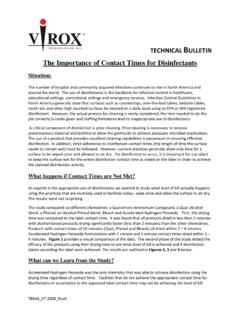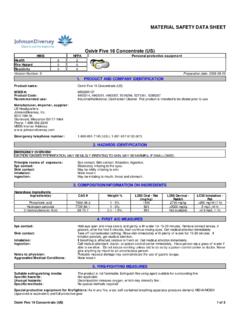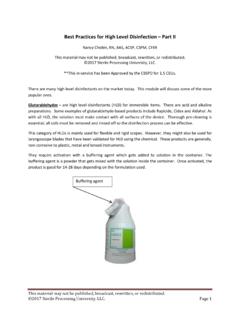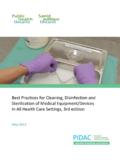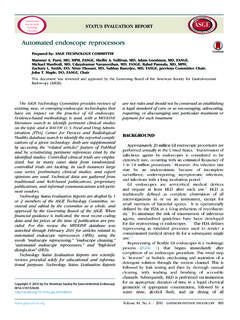Transcription of Critical & Semi-Critical Equipment
1 Reprocessing (Cleaning, disinfection & sterilization ) Critical & semi - Critical Equipment - A Physician Toolkit - Reprocessing Critical & semi - Critical Equipment - A Physician Tool Kit Table of Contents Preface ..1 Basic Physician Office Supplies for Reprocessing and semi - Critical Medical Equipment ..2 sterilization Monitoring ..3 Policies, Procedures & Guidelines ..4 Reprocessing Medical Equipment Policy, Procedures & Policy Template for Reprocessing of Medical Procedure Template for Steam sterilization ..10 Procedure Template for High Level disinfection ..11 Control Sheet Template for Cleaning and disinfection of Flexible Endoscopes Manually ..13 Control Sheet Template for Cleaning and disinfection of Flexible Endoscopes Using Automated Endoscope Reprocessor.
2 14 sterilization Log Template ..15 Common Deficiencies ..16 Cleaning, disinfection & sterilization Reprocessing Critical & semi - Critical Equipment - A Physician Tool Kit Preface This document, A Physician Toolkit for Reprocessing Critical and semi - Critical Medical Equipment , has been developed to assist office physicians and their staff to meet best practice standards on reprocessing medical Equipment . Additional references and standards that physicians and their staff should be aware of and compliant with are: Provincial Infectious Diseases Committee (PIDAC) Best Practices for Cleaning, disinfection and sterilization , 2006; Canadian Committee on Antibiotic Resistance (CCAR) Infection Prevention & Control Best Practices, 2007; and A Physician s Guide to Occupational Health and Safety Responsibilities.
3 Links to all of the above noted references are available on the College s website at Reprocessing Critical & semi - Critical Equipment - A Physician Tool Kit - 1 Basic Physician Office Supplies for Reprocessing Critical & semi - Critical Medical Equipment Personal Protective Equipment (PPE) Face Protection: mask, protective eye ware (safety glasses or goggles) and/or full face shield). Gloves: gloves must be of sufficient weight to be highly tear resistant (regular exam gloves are not appropriate protection for reprocessing). Gowns: gowns must be of a quality to provide an adequate barrier to moisture (isolation gowns are not appropriate). Cleaning Brushes (reusable or disposable) or cloths for physical cleaning.
4 Detergent or enzymatic cleaning solutions ( Medzyme). High Level disinfection High level disinfectant solution ( Glutaraldehyde). Products must have a Drug Identification Number (DIN) from Health Canada. High level disinfectant solution chemical test strips. Log and documentation record forms. sterilization (manufacturers may have starter kits which include all of the products listed here) External chemical indicator/autoclave tape (maybe built-in with peel pouches) placed on packages with each load. Internal chemical indicator: placed inside each package for sterilization . Biological indicator (spore-laden strips or vials) (usually Geobacillus stearothermophilus for steam sterilizers). Used once each day the sterilizer is in use, or with every load if sterilizing implantable devices.
5 Logs books/forms for documentation of sterilization parameters and autoclave maintenance. Reprocessing Critical & semi - Critical Equipment - A Physician Tool Kit - 2 sterilization Monitoring sterilization of medical Equipment is a two-step process involving: (i) Decontamination (aka cleaning) to remove >80% of microbes; and (ii) sterilization to kill the remaining microbes. Steam autoclaves are the most efficient and non-toxic method of sterilization in a physician office setting. Because of the difficulty in proving the sterility of a medical instrument, the effectiveness of the sterilization process must be monitored. Three complementary types of monitoring are required: Mechanical/Digital indicators to monitor the autoclave s physical parameters (time, temperature and pressure) for each cycle/load; Chemical indicators - external indicators on the outside of each wrapped package and internal chemical indicators inside each package, which change color when exposed to the right conditions for sterilization ; and Biological Indicators that confirm the actual annihilation of microbial spores.
6 All three types of monitors are important to confirming that the conditions necessary to achieve sterility have been met. Among these, biological indicators may be the most unfamiliar to physicians. Options for biological monitoring include: Purchasing a self-contained testing kit with incubator for on-site monitoring; or Purchasing only the spore strips, and then transporting them to a microbiology laboratory that offers environmental testing. (Unfortunately, few laboratories in the province offer this service.) Reprocessing Critical & semi - Critical Equipment - A Physician Tool Kit - 3 Policies, Procedures & Guidelines The following policies, procedures, guidelines and templates are not official documents of the College of Physicians & Surgeons of Alberta.
7 They are provided for information only. We hope these documents will assist you in creating your own specific documents for your office setting. Comments and questions can be forwarded to Reprocessing Critical & semi - Critical Equipment - A Physician Tool Kit - 4 Reprocessing Medical Equipment Policy, Procedures & Guidelines The following information is provided to assist you in developing policies and procedures relating to reprocessing of medical Equipment in the office setting. Templates for developing office/clinic based policy and procedures are included. A. General Requirements: 1. Medical Equipment that is to be reprocessed must be labeled reusable by the manufacturer and must be accompanied by the manufacturer s written instructions for reprocessing (cleaning, disinfection and sterilization ).
8 2. Critical or semi - Critical medical Equipment labeled as single use or disposable shall not be reprocessed. 3. In order to determine the level of reprocessing that is required for a piece of medical Equipment , the following risk classification is used: Critical Equipment - contacts sterile tissue or the vascular system and requires sterilization . (surgical instruments, biopsy forceps, suture scissors, devices entering sterile body cavities, etc.) semi - Critical Equipment - comes in contact with intact mucous membranes or non-intact skin and requires a minimum of high level disinfection (vaginal specula, nasal specula, vaginal/anal ultrasound probes, gastro-intestinal/nasopharyngeal endoscopes, laryngoscopes, etc.) 4.
9 Medical Equipment reprocessing must take place in a designated area that is separate from patient care areas, or is not to occur when patients are present. 5. Personnel responsible for reprocessing in the office setting must have documented training. 6. Office-specific procedures are developed for medical Equipment reprocessing that are written, current, and incorporate existing recognized standards of practice ( PIDAC, CCAR and AH&W). Manufacturer s instructions must be accessible and incorporated into office specific procedures. 7. Personnel responsible for reprocessing must wear the appropriate personal protective Equipment (PPE) ( gowns, gloves and facial protection) while reprocessing medical devices. 8. At least one dedicated sink or hand hygiene station must be present in the reprocessing area.
10 Reprocessing Critical & semi - Critical Equipment - A Physician Tool Kit - 5 9. Medical Equipment is to be stored in clean areas that are protected from contamination, vermin, excessive handling and crushing. They are NEVER stored beneath the sink, in the soiled Equipment cleaning area or in the immediate area where examinations/procedures are performed ( beneath the end of the table where pelvic exams are done.) B. Cleaning: 1. All medical Equipment must be cleaned first, using water and detergents or enzymatic solutions that are appropriate for use on instruments, prior to any subsequent disinfection or sterilization . 2. Detergents or enzymatic solutions are used according to manufacturer s instructions that are written on the label.



